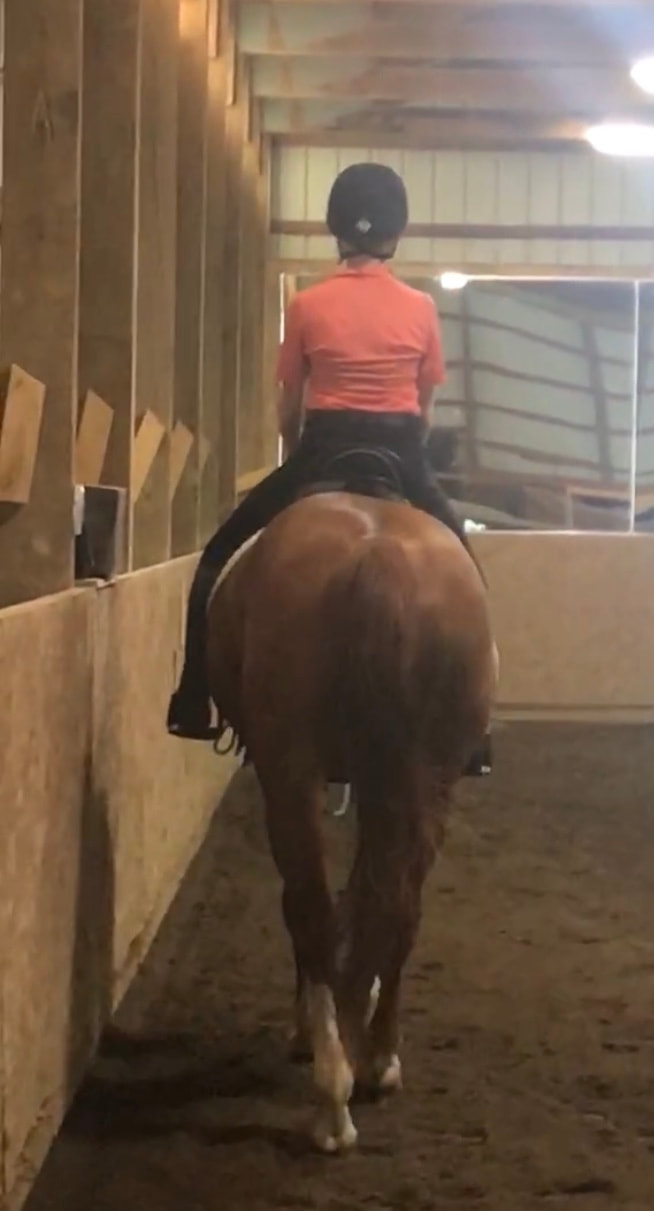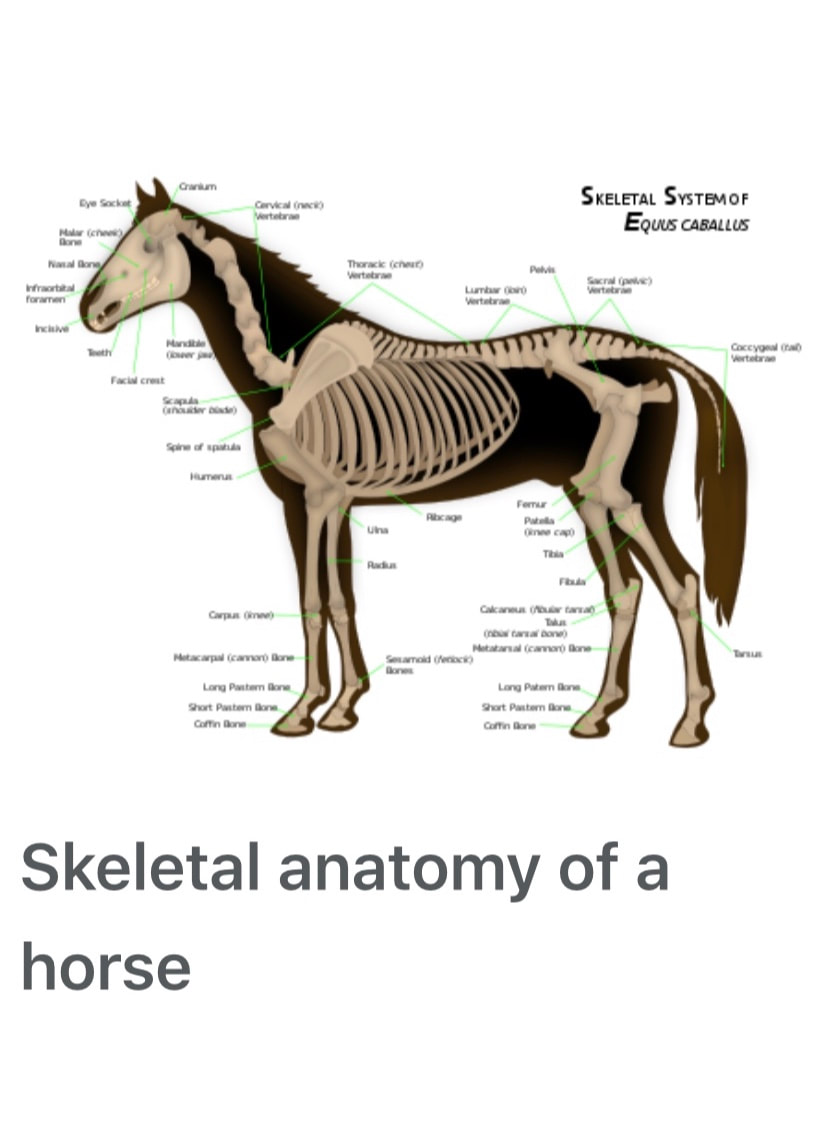|
Are you riding your horse’s body? Have you ever wondered if you are riding your horse’s body? Do you know what that means and why it is important? In this blog, I am going to share the concept of ‘riding your horse’s body’ in more detail along with a few exercises to help you become more aware of what this should feel like. Confirmationally, the horse was never really meant to be ridden. This is something we humans came up with for our convenience. Some research has indicated that we should not have more than 120 pounds on a horse’s back including the tack. Therefore, riding centered, balanced, and correctly is pertinent to the health and longevity of the horse. The weakest part of a horse’s body is where we sit on their back. I refer to this area as the ‘bridge.’ The reason I call it the ‘bridge’ is because the horse's ribs and vertebrae are what connect the hips to the shoulder. Have you ever sat on your horse and it feels as though one stirrup is shorter than the other? Usually, it feels like the left is shorter than the right. The reason you feel this is because the ribs are pushed to one side as opposed to the other. For example: Sit on your horse and you should feel that your right leg does not have as much pressure under your calf area as your left calf does. That is because on the right side of your horse it is their ribs in their shoulder area that are pushed out against your thigh, not your calf. Then on the left side, you will feel more pressure under your calf. Each side has ribs that are pushed out further on that side and not the other. Think about it, when you ride your horse to the right your horse usually falls in with their shoulders leading and when you ride to the left side your horse tends to lead with their hunches. This is why your left stirrup usually feels shorter. Your horse’s last eight ribs are pushing against your calf. Go ahead try it, it is a very cool feeling. (Down below, you can see a picture of the left belly pushing out the rider's left calf.) So, back to riding your horse's body. As you are sitting on your horse and on the left side, their ribs are pushing out up against your calf, that is a place where your horse is not truly straight and on the right side, the ribs under the shoulder (your thigh area and girth area) are pushing out and putting pressure on your thigh. This too is another place that they are not straight. All this keeps us from connecting the hips to the shoulders, which then would allow us to connect the bridge, make our horses straight, and then build a place for us to sit. Here is another cool exercise to be able to see the bridge up and connecting the hips to the shoulders: Take a hoof pick and scratch under your horse's belly from between their front legs (the girth area) to the middle of their belly. Watch how tall they get and see the bridge connect between the wither and shoulder area to the hips. When your horse is fine with this, then get on your horse and have someone do it while you're sitting on them in the saddle. (You don’t want to do this bareback because the horse doesn’t have the muscle to support you for the bridge to come up). This is what you want to feel when you are riding your horse. This is the bridge that connects the hips to the shoulders! And, it gives you a great place to sit! (See the second picture below.) As you did this, did you notice that your horse naturally put his or her head and neck down? I find this amazing! What do you think? A lot of training methods only focus on the headset and flexing the neck. So much time is spent on trying to get our horse’s heads and necks down and we forget about the rest of the body. When we take the time to learn how to line up all 18 of the horse’s ribs, the rest of the body comes together naturally— and just like that the head and neck come into place too! I know I make it sound easy and that is not exactly the case. First of all, you need to be able to know how to sit in the middle of your horse. We put a saddle on our horse and think all we have to do is sit in the middle of our saddle and then we can get our horses straight. It is not that simple nor does that equal straightness. When you put a saddle on a crooked horse, it does not make your horse straight. A properly fitted saddle is just a small piece of the puzzle. Many variables go into making a horse straight. Here is another exercise for you to try: Sit on your horse and line up your zipper to their mane and wither area (make sure your zipper is in the center of your body). As you do this, you should also feel if your stirrups are now even. Sitting in the middle of our horse lets us understand where our horse's ribs are pushed out and stuck. When we don't sit in the middle of our horse, we affect how the ribs stay stuck to one side or the other. This puts us in what I call a hole (the hole is usually the outside of our horse). So now you are probably asking, “Okay, so how do I do this?” The first step is you need to be able to support yourself while riding your horse at the walk, trot, and canter. This means NOT USING YOUR STIRRUPS OR YOUR REINS! The reason for this is that we need to become independent of our horses so we can influence our horse’s bodies. We do not want our horses to influence our bodies. Another common question I am frequently asked is, “How do I do this and where do I place my balance?” Ideally, it starts with a straight pelvis, which is then supported by strong core and back muscles. Just like our horses, we are all front end driven. The backside of our body is very weak just like our horses. So, we need to fix our tilted pelvis and then strengthen our core and back muscles. When we have these basic things in place, then we have a foundation to build upon. After we have built this foundation, we can now place our lower leg around our horse’s back ribs and start to feel where they are not moving and where they are only moving from center to one side. This gives us a great place to start! In summary, when you are riding your horse’s legs and not the entire body, you may experience the following six things:
If you are riding your horse's body, neither of your reins is heavy and your horse can stretch down long and low. Your horse never gets quick in the gaits. You always get the right diagonal and proper lead. Your direction changes are smooth and easy. And, your transitions are smooth and balanced. So now that you have this new awareness about riding your horse’s body and not just the head and neck, I challenge you to give it a try the next time you ride. Practice the exercises I gave you and see what your horse shows you. Before After
6 Comments
|
AuthorWrite something about yourself. No need to be fancy, just an overview. Archives
September 2020
Categories |





 RSS Feed
RSS Feed